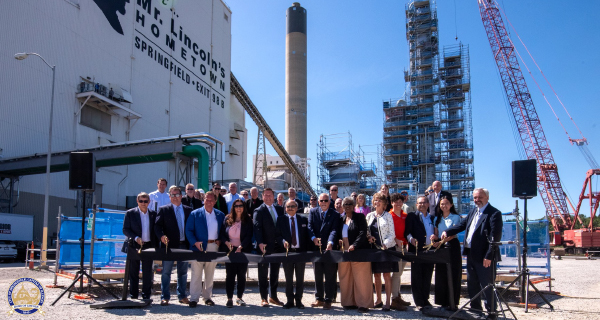Springfield, Illinois public power utility City Water, Light & Power in June celebrated the near completion of construction for its 10-megawatt-electric slipstream carbon capture pilot project for the U.S. Department of Energy.
Led by the University of Illinois’ Prairie Research Institute, and its partners including the Linde Group, BASF Corporation, Affiliated Engineers, Inc., Affiliated Construction Services, Inc., and Visage Energy, this project will rank among the world’s largest carbon capture pilots.
Attendees at the ribbon-cutting in June included, among others, Doug Brown, Chief Utility Engineer of City Water, Light and Power, Kevin Obrien, Director of the Illinois Sustainable Technology Center and the Net-Zero Center of Excellence at the Prairie Research Institute; Springfield Mayor Misty Buscher; Ronald Munson, Point Source Carbon Capture Technology Manager, NETL, U.S. Department of Energy.
Also in attendance at the event was Jessica Wood, Manager for Environmental Policy at the American Public Power Association.

Under the pilot project, a slipstream is being pulled from Dallman Unit 4 unit and used to evaluate the performance of a new capture technology developed by Linde/BASF.
The pilot will evaluate a new large scale capture system for its performance and economics. The technology’s performance and economics will be compared to predictions.
The carbon capture system is based on a BASF proprietary solvent coupled with a Linde proprietary design that reduces regeneration energy, lowers solvent circulation rates, and enhances heat recovery.
These results are critical for proving the technology, ensuring energy efficiency and reducing overall carbon dioxide (CO2) recovery costs. The pilot system will process approximately 5 percent of the unit’s flue gas, from which it will demonstrate the ability to capture over 90 percent of the slipstream’s CO2 emissions (equivalent to 200 tonnes of CO2 per day).
The project was selected through a competitive selection process by the US Department of Energy / National Energy Technology Laboratory.
The project, which initially started in 2018, has successfully transitioned from engineering design to construction.
The construction phase of the project is due to be completed in November. Thereafter, the project will transition to a testing phase.
The total cost of the project was approximately $85 million, with approximately $58 million from the US Department of Energy, $20 million from the state of Illinois, and $7 million from Linde.
The project was strongly supported by local trade unions. Union labor was used during construction and will be used in the operation of the unit.
The features and capability of this system draws international attention to the city of Springfield. Already many international researchers in carbon capture have toured the site.
The facility will enable the state of Illinois to continue to be a leader in the research, development, and deployment of carbon capture.
This technology provides a means to not only reduce CO2 emissions from the power generation sector, but also industrial sectors. The project marks a significant step in showcasing the economic viability of carbon capture, the impact of stimulating workforce development in the trades, and a means to educate and train workforces.

